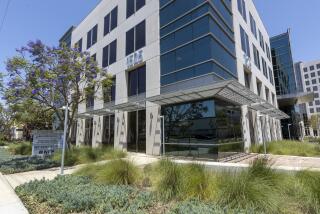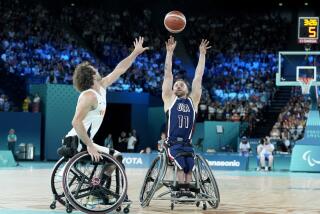Progress Hits a Roadblock
Just about every morning when Chapman University political science professor Art Blaser heads off for the campus, someone unwittingly breaks the law to block his path.
Blaser is a quadriplegic who treks to work in his electric wheelchair. But not everyone respects a wheelchair user’s need for a full sidewalk. Campers, SUVs or vehicles parked two deep in a driveway, hanging over the sidewalk, can be an obstruction for those in wheelchairs. Blaser often faces obstacles in his path three or more times a day.
And it’s not just inconvenience that he and other wheelchair users deal with. Barriers for wheelchair users pose a safety problem.
The U.S. Consumer Product Safety Commission estimates that 80,000 wheelchair users a year suffer injury from some type of chair accident.
The state Department of Rehabilitation estimates that 6.2 million Californians are disabled. Many are wheelchair users. State rehabilitation officials are trying to improve conditions for them by monitoring public compliance with the 1990 Americans with Disabilities Act (ADA). But they lack enforcement powers, and some of the requirements for local governments are ambiguous. The best remedy, says its oversight director, Michael Paravasna, is to educate the public.
It’s not just city governments causing problems, he says. It’s often the wheelchair user’s friends and neighbors who don’t even know they’re creating a danger.
“It’s just not on some people’s radar screen,” said Larry Howard, a psychologist in the Human Resources Division of the county’s Health Care Agency, who uses a wheelchair.
Blaser agrees: “People really don’t mean to be insensitive; they’re just unaware.”
Many wheelchair users pointed out obstacles that few think about:
* Sidewalks buckled from age or tree roots, which force a wheelchair user into the street to avoid them. Such repairs are rarely high on the list for funding in most cities with tight budgets.
* Sprinklers improperly positioned so that sidewalk users get sprayed. Wheelchair users don’t have the option of running quickly through the water..
* Doorways in older buildings too narrow for easy wheelchair access.
* Commercial buildings that have filled up the bathroom stall for disabled people with either a chair or a diaper changing table, making it difficult to maneuver a wheelchair.
* Restaurants with outdoor eating where some patrons push their chairs all the way to the sidewalk and don’t put them back. Some restaurants place potted plants or signs in the middle of sidewalks in front of their businesses.
* Crowded store aisles.
*
Each year, Phyllis Collier of Irvine writes a letter to store owners in her city, cautioning them about aisle dangers for wheelchair users. Collier is a member of the city’s disabilities advisory board. She also uses a wheelchair.
“Holidays are the worst,” she said. “The stores want to offer lots of sales, and the best way to get people’s attention is to stack them in the aisles. Some stores have improved since our annual letter, but with many it’s still a problem.”
* Traffic problems.
A five-year study by the The National Highway Traffic Safety Administration showed injuries to 2,000 pedestrian wheelchair users.
Wheelchair users point out that traffic lights at many intersections simply do not remain green long enough to let them cross safely.
Jason Strong, a 27-year-old Cal State Fullerton junior, says crossing a street, at either a traffic signal or a pedestrian crosswalk, can be frightening.
“You get out there and you see a driver coming at you real fast, and you think, ‘Should I go back, or should I try to hurry across to the other side?’ Sometimes you just freeze you’re so scared.”
Strong says such obstacles come daily. But he almost never gets angry.
“Frustrated, but not angry,” Strong said. “Because most people who cause you problems, if they stopped to realize it, they’d really want to do the right thing.”
* City blocks without curb cuts (ramps at corners), or curb cuts at only one end.
Irvine’s Collier is still boiling about a letter to the editor she read. The writer, arguing against money spent on curb cuts, asked why wheelchair users can’t just go down a driveway to get to the next block.
“Can you imagine anyone being that insensitive?” Collier asked.
But often workers do make a point of recognizing problems. The county’s Howard, who also teaches at UC Irvine, says sometimes a welcome gesture is something as simple as setting a fax machine on a lower table so a wheelchair user has access to it.
“But some things we in wheelchairs just have to learn to deal with,” Howard said. “Stores wouldn’t be able to stay in business if they couldn’t stack items high on shelves. But my experience is, if you ask someone in a store for help, they’re usually great about it.”
Wheelchair users agree that things are much better than they used to be. Not only has public awareness improved, they say, but the 1990 disabilities act has forced municipalities to improve conditions.
*
Paravasna of the state Department of Rehabilitation says he gets calls almost daily from government officials, schools and private companies seeking information on how to improve compliance with ADA. But he says many violations still occur. A few examples:
* Hard-to-open doors at many schools, businesses and even government offices.
* Steep ramps. Some businesses think they’re complying with the law by installing wheelchair ramps, but they make them too steep. The law says only one inch of rise for every foot of length, Paravasna said. But some businesses think that takes up too much space.
“There’s a real danger on some of these ramps of a wheelchair tipping over,” he said.
* Parking lot spaces. Many businesses, Paravasna said, create a configuration that’s dangerous for wheelchair users. For example, some will place spots for company vehicles closest to the store doors, instead of the spots for disabled people.
“Any time a wheelchair user has to go around the back of another vehicle it poses a threat,” he said.
The good news is that most people, once they do become more aware, usually become more sensitive to the problem.
“We’ve yet to meet anyone who wants to be a problem for a wheelchair user,” Paravasna said.
Even other wheelchair users. Howard, from county government, says he often does not park in a spot for the disabled.
“I have upper-body use,” Howard said. “If I see that there’s only one or two spots available, I always figure there’s someone who needs it a lot worse than I do.”
Cal State Fullerton’s Strong sums up how many feel: “My goal is just to be able to function in society, the same as everyone else.”
More to Read
Sign up for Essential California
The most important California stories and recommendations in your inbox every morning.
You may occasionally receive promotional content from the Los Angeles Times.










